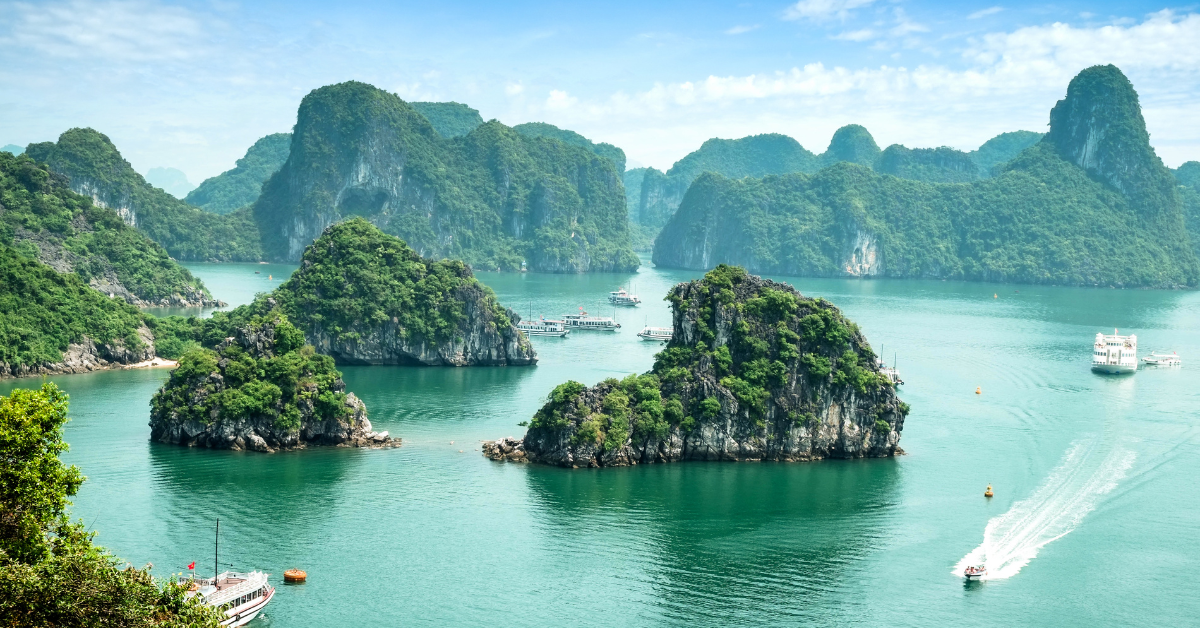Ha Long Bay, a UNESCO World Heritage Site, is famous for its thousands of limestone islands and emerald waters. While visitors from around the world admire its breathtaking scenery, Japanese travelers often see it through a unique cultural lens. Their perception is shaped by values of harmony, silence, and seasonal beauty. Understanding this perspective allows foreign visitors to enjoy a deeper and more meaningful experience of Ha Long Bay.
The Unique Appeal of Ha Long Bay for Japanese Travelers
A Landscape Like an Ink Painting
Japanese people treasure the changing seasons and often find beauty in subtle natural transitions. The misty limestone islands at dawn and the silhouettes at sunset are particularly moving to Japanese travelers. While many Western visitors consider clear skies and sunshine as the ideal conditions, the Japanese often describe cloudy or hazy scenes as “yūgen” (mysterious, profound beauty), appreciating them as part of the experience.
Silence and Harmony with Nature
During a cruise in Ha Long Bay, the only sounds are the waves and the calls of seabirds. This silence itself becomes a source of healing for Japanese travelers. The value placed on harmony with nature strongly influences how the Japanese evaluate their experience here.
Japanese Travel Styles in Ha Long Bay
From Group Tours to Individual Travel
In the past, most Japanese visited Ha Long Bay as part of large group tours. Today, however, more travelers prefer private trips or small-group cruises. Instead of choosing lively party boats, they often opt for luxury or boutique ships that offer a calm and serene environment. This reflects the Japanese tendency to prioritize tranquility over excitement.
Culinary Expectations
Food plays a central role in Japanese travel. The fresh seafood of Ha Long Bay is highly praised, especially crab and shrimp. However, dishes that are oily or heavily seasoned may receive mixed reviews. Japanese visitors tend to value preparation methods that highlight the natural flavors of ingredients.
Evaluation Points of Japanese Tourists
| Evaluation Aspect | Distinctive Japanese Perspective |
|---|---|
| Scenic Beauty | Favor misty, hazy views described as “yūgen” and ink-painting-like |
| Cruise Experience | Prefer small-group, calm environments |
| Food | Emphasize freshness, expect delicate seasoning |
| Service | Value politeness, cleanliness, and a sense of security |
| Weather | View cloudy or rainy days as having unique charm |
Experiences and Cultural Backgrounds
Connection to Traditional Arts
In Japanese culture, nature has long been a central theme in art—haiku, waka poetry, folding screens, and ink paintings often depict mountains, rivers, and misty landscapes. For Japanese travelers, Ha Long Bay resonates with this aesthetic, sometimes feeling like a “familiar beauty in a foreign land.”
Travel as Healing
For many Japanese, modern life is busy and stressful, making travel an opportunity for rest and mental healing. A cruise in Ha Long Bay is not just about sightseeing—it allows for reading on deck, sipping tea, and appreciating stillness. These quiet activities themselves are seen as meaningful travel experiences.
Japanese vs. Foreign Cruise Styles
| Category | Japanese Preferences | Foreign Traveler Tendencies |
|---|---|---|
| Leisure Style | Quietly observing scenery, waking early for sunrise | Enjoying night shows, music, and socializing |
| Food Experience | Seek delicate flavors, focus on ingredients | Prefer volume, bold seasoning, and presentation |
| Travel Purpose | Value healing and silence | Often seek entertainment and social interaction |
| Cruise Type | Choose small, intimate ships | Favor large ships with lively atmosphere |
Japanese Perception of Weather
While many foreign visitors wish for sunny days, Japanese travelers find beauty even in cloudy or rainy conditions.
| Weather Condition | Japanese Perception | Foreign Perception |
|---|---|---|
| Clear Skies | Bright and refreshing | Ideal sightseeing condition |
| Cloudy | Enhances quietness, seen as “atmospheric” | Often considered disappointing |
| Light Rain/Mist | Mysterious, ink-painting-like beauty | Viewed as inconvenient |
| Heavy Rain | Opportunity for rest indoors | Perceived as negative, limiting |
Expectations of Service
| Service Category | Japanese Standards | Other Travelers’ Standards |
|---|---|---|
| Hospitality | Expect polite, respectful interaction | Prefer friendliness over formality |
| Cleanliness | Demand high hygiene standards on board | May prioritize convenience over hygiene |
| Sense of Safety | Highly value safety and attentive care | Often more relaxed about risks |
| Time Management | Emphasize punctuality and efficiency | More tolerant of delays |
Advice for Foreign Visitors
Understanding the Japanese perspective can open new ways to enjoy Ha Long Bay. For example, instead of only seeking clear-sky views, try appreciating mist, rain, or haze as special and poetic sceneries. Likewise, consider setting aside time to enjoy the natural silence of the bay rather than focusing solely on entertainment. By doing so, you can experience Ha Long Bay in the same restorative and profound way that Japanese travelers do.
Conclusion
Ha Long Bay attracts visitors worldwide, but for Japanese travelers, its essence lies in the harmony between natural beauty and inner peace. Mist-shrouded karsts and the quiet sea echo Japan’s aesthetic values, providing a deeply moving experience. For foreign visitors, learning about the Japanese perspective can enrich your own journey, turning a beautiful cruise into a memorable, soul-soothing encounter with nature.






